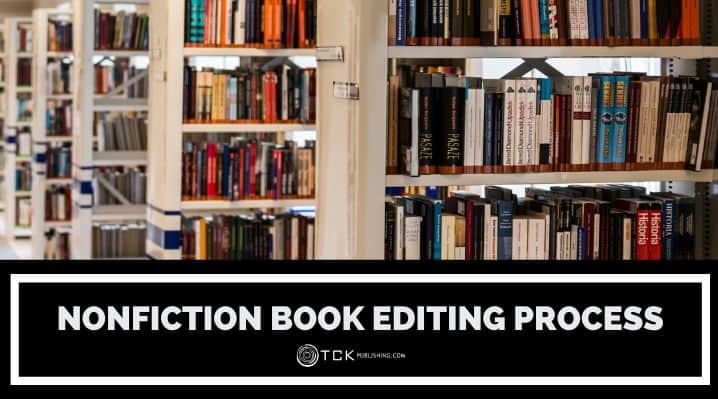
Many writers forget that the writing bit is just one step in a multi-stage process. In some cases, it’s not even the most challenging.
You’ll need to do a lot of editing to create a polished, engaging, and commercially viable book. Let’s take a look at all the stages a nonfiction manuscript goes through before it is ready for printing.
Nonfiction Editing
Whether you land a traditional book deal or self-publish, your nonfiction book has to be the best it can be. This means editing it to improve its clarity, coherence, accuracy, and overall readability.
Think of how jewelers take a dull, unpolished gemstone and refine it into a multifaceted and sparkling jewel. The result is a more valuable piece that attracts both sellers and consumers.
Low-quality books don’t get book deals. Readers avoid poorly made books. Good editing will be what separates you from the competition.
Traditional publishers have their own editorial team. Even then, with the volume of manuscripts they work on, you have only a slim chance of getting noticed. This is why some writers hire editors or do it themselves before even submitting their work to a publisher.
And you can self-publish anything at any degree of quality. It doesn’t mean you’ll be successful though. Both routes need a solid editing process that can level up your work to a readable and sellable level.
The Book Editing Process
The book editing process will be slightly different with each editor. They all bring different skills, experiences, and perspectives. However, many of them will agree that editing a manuscript can be broadly categorized into the stages below.
1. Developmental Editing
Also called structural, substantive, or content editing, this stage is about evaluating your manuscript’s overall content, structure, and message. Developmental editors specifically focus on your story, tone, central arguments, pacing, style, and organization.
What’s the vision of the manuscript? Does the structure make sense? How can it be more coherent and compelling? Does it fit the intended audience?
This stage can take the longest as it considers the big-picture elements. The changes or suggestions an editor makes here have the most significant effects on your work. Its goal is to ensure a strong foundation for your work and ready it for the next stages of editing.
2. Line Editing and Copy Editing
These two types of editing are technically different but can be done at the same time. Both line and copy editors look at your work at the paragraph and sentence level. They’re less focused on the story and more on your language and grammar.
Line editors look at your work at the paragraph and sentence level. They focus on word choice, sentence structure, syntax, flow, and consistency. Their goal is to smoothen out your text by removing or changing unclear, repetitive, or unnecessary words and sentences. They also correct inconsistencies as well as suggest alternatives for overused phrases.
Copy editors concern themselves with grammar, spelling, punctuation, formatting, and fact-checking. Their goal is to make sure your manuscript adheres to grammar rules, style guides, and publishing standards.
3. Proofreading
This is the final stage of the nonfiction book editing process. It’s the final checking of your manuscript before it is sent out for publication. It is also, by its nature, the stage with the lightest work.
That doesn’t mean it is the easiest. Proofreaders review the entire manuscript to ensure no typos, misspellings, or formatting issues are present. They also check that font sizes, line spacing, and other technical elements are consistent and correct.
A manuscript involves many lines of text. Despite careful editing, some errors may have slipped through. This is your final chance to catch these errors.
Other Steps
Aside from the three above, the book editing process can involve a few other stages. These are optional but can be a big benefit to developing your manuscript.
Beta Readers
Beta readers can give you feedback about your manuscript early into the process. They provide feedback on their reading experience and help identify issues in your work.
Most beta readers will focus on the big picture though they will note any technical issues they notice. Remember, they aren’t professional editors but readers willing to check your work out and provide input. You also don’t need to consider every feedback they give—you’re the author and decision maker.
Anyone can also be a beta reader. However, the best ones are usually your fellow writers or strangers. The first knows the craft while the second has no issues with being objective.
But if you’re just starting out, your beta readers are most likely going to be your family or friends. In this case, tell them you’re not looking for praise and are seeking honest criticism.
Self-edits
This isn’t actually an optional stage. Rather, it’s something you do naturally and automatically when writing. You go through multiple drafts simply by reworking chapters, polishing concepts, and so on.
Writers only differ in how intentional they are with their self-edits. Some writers are casual with it, preferring to let professional editors handle the heavy editing. Others can get a bit more obsessive.
Self-editing also improves your overall skills as a writer. In the process, you get to learn what mistakes to not repeat, how elements come together, and how to improve your particular style and voice.
However, you also need to be aware of the dangers of self-editing. As you’re deeply involved with your manuscript, you might—consciously or not—fail or hesitate to acknowledge its issues. This is why working with a professional editor is often recommended.
Final Thoughts
As an author, it’s great to be aware of your book’s strengths and weaknesses. This gives you an idea of what to change or improve, which can be helpful to any editor you work with.
Whether you choose to work with an editor or do it yourself, it is an essential step to becoming a published author. This is especially crucial to nonfiction as your book’s quality often affects whether readers perceive you as a subject matter expert and reliable source of information.
Approach this task carefully and thoughtfully. Anything can happen during the editing process. Small changes can take you in a different direction and big changes can subtly impact your meaning. But whatever happens, good editing will always let your writing thrive.
What is your take on the book editing process? Share your thoughts below!
If you enjoyed this post, then you might also like:
- Types of Editing: Knowing What You Need When
- Copy Editing: What It Is and How You Can Do It
- Line Editing: What It Is and Why You Need It
- Developmental Editing: What to Look For and How to Find the Right Editor

Cole is a blog writer and aspiring novelist. He has a degree in Communications and is an advocate of media and information literacy and responsible media practices. Aside from his interest in technology, crafts, and food, he’s also your typical science fiction and fantasy junkie, spending most of his free time reading through an ever-growing to-be-read list. It’s either that or procrastinating over actually writing his book. Wish him luck!
